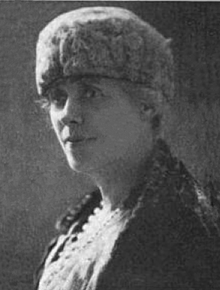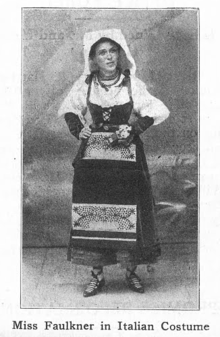Georgene Faulkner
Georgene Faulkner (1873 – 1958) was a prominent American children's book author and storyteller of the early twentieth century.[1] In her career, she was known and promoted as "the Story Lady."


A native Chicagoan, she attended the School of Education of the University of Chicago, then at the forefront of educational reform. When her sister Elizabeth Faulkner started the Faulkner School for Girls in 1909, Georgene was in charge of the kindergarten.[2] She was an accomplished storyteller; she dressed up as Mrs. Santa Claus to tell Christmas stories to children.[3] She also practiced her craft with adult audiences: she traveled to Europe to entertain American troops during World War I.
Beginning in 1922, Georgene Faulkner began broadcasting on Chicago radio stations; on stations WMAQ and WGN she had programs titled "The Story Lady" and "Air Castle."[4][5] She also wrote on children's topics for the Chicago Tribune.
Over the space of four decades she wrote or edited a range of children's books. Several of her works were illustrated by Frederick Richardson. In the final phase of her career she addressed the problem of racial prejudice, in the books Melindy's Medal (with John Becker, 1945) and Melindy's Happy Summer (1949).[6]
Selected works
- Old Russian Tales (1913)
- Italian Fairy Tales (1914)
- Christmas Stories (1916)
- Old English Nursery Tales (1916)
- Red Cross Stories for Children (1917)
- The Story Lady's Book (1921)
- Through Story-Land with the Children (1924)
- Tales of Many Folk (1926)
- The Story Lady's Nursery Tales (1927)
- Story Lady's Christmas Stories (1927)
- Little Peachling, and Other Tales of Old Japan (1928)
- The White Elephant and Other Tales from Old India (1929)
- The Road to Enchantment: Fairy Tales from the World Over (1929)
- The Golden Fish: Fairy Tales from the World Over (1931)
- Melindy's Medal (1945)
- Melindy's Happy Summer (1949)
- Hidden Silver (1952)
References
- Alberta Lawrence, Who Was Who Among North American Authors 1921–1939, 2 Volumes, Detroit, Gale Research, 1976.
- A Handbook of American Private Schools, Boston, Porter Sargent, 1922; p. 218.
- Robert C Hoffman, Postcards from Santa Claus: Sights and Sentiments from the Last Century, Garden City Park, NY, Square One Publishers, 2001; p. 30.
- Leora M. Sies and Luther F. Sies, The Encyclopedia of Women in Radio, 1920–1960, Jefferson, NC, McFarland & Co., 2003.
- Mark Jacob and Richard Cahan, Chicago Under Glass: Early Photographs from the Chicago Daily News, Chicago, University of Chicago Press, 2007; p. 212.
- Diana Johnson-Feelings, Telling Tales: The Pedagogy and Promise of African American Literature for Youth, Westport, CT, Greenwood Press, 1990; p. 106.
External links
- A photograph of Faulkner
- Works by Georgene Faulkner at Project Gutenberg
- Works by Georgene Faulkner at LibriVox (public domain audiobooks)
